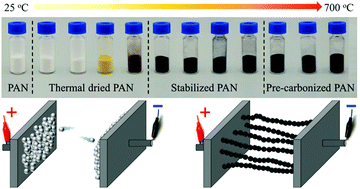Switchable electrorheological activity of polyacrylonitrile microspheres by thermal treatment: from negative to positive†
Abstract
The study focuses on the effect of thermal deformation degree of polyacrylonitrile (PAN) particles on the electrorheological (ER) properties of their suspensions. The heat-treated PAN particles are manufactured as ER materials using a thermocatalytic processes. The molecular structures of ER materials are analyzed to confirm a stabilization or a carbonization degree. We categorized the prepared ER particles into three basic types according to their deformation degree: Thermal dried PAN, stabilized PAN, and pre-carbonized PAN. The raw, stabilized, and pre-carbonized PAN particle-dispersed suspensions showed positive ER properties. The ER properties are enhanced as the heat-treatment temperature increases due to improved dielectric property. However, the thermal dried PAN particle ER suspensions showed negative ER behavior though the particles have higher conductivity and dielectric constants than those of the host fluid, which is contrary to the conduction model. XRD results indicate that the ER materials could show contradictory ER behavior even if they have the same molecular structures due to their crystallinity. This discovery is expected to boost the development of both positive ER and negative ER suspensions based on carbonaceous ER materials.



 Please wait while we load your content...
Please wait while we load your content...